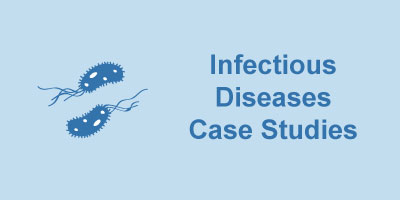Case Study 1: What is this mysterious disease?

This case study examines the earliest reports of what we now know were AIDS cases. The medical community was perplexed and the public was scared because the cause of this disease and mode of transmission were not understood. Students will use the data provided to think about how scientists can look for meaningful patterns in data and how they practice formulating a scientific question — that is, one that can be answered through experiment or observation.
Many unresolved questions remain at the end of the lesson, illustrating the iterative nature of science and how science is not a list of facts to memorize but a process of discovery. The concepts presented here align well with those presented in ID Unit 1.
Download Case Study 1 here.
Case Study 2 — Do bacteria cause stomach ulcers? Applying Koch’s postulates

This study grapples with the problem of arriving at causation from correlation with respect to infectious disease. First, students will discuss their stomach ulcer homework, and they will compare their predictions to real life excess-acid experiments in people. This is a key point because the results support the hypothesis; however, they do not prove causation. Next, students will design experiments that predict results for experiments to test the hypothesis that stomach ulcers are caused by an infectious agent. Students will then consider the implications of not being able to fulfill all of Koch’s postulates with Helicobacter pylori.
Download Case Study 2 here.
Case Study 3 — Where did HIV come from? Tracing the origin of disease

Prior to 1980, there were no reports of AIDS in the medical literature, but by 1987 the World Health Organization reported that an estimated 5-10 million people were living with HIV worldwide. The rapid emergence of this disease was indication that it might have “jumped” from an animal host. This is similar to flu viruses that are thought to have originated in birds. Most human viral diseases do originate in animals. In this case study, students develop a hypothesis and make predictions. Throughout the lesson, students will analyze and interpret a variety of data. The accumulation of results helps to support the hypothesis that HIV originated from a chimp virus.
Download Case Study 3 here.
Case Study 4 — Antibiotic resistance

In this study, students synthesize information from different studies to arrive at a model to explain how human antibiotic resistant infections may be linked to antibiotic use on farms. Importantly, the evidence does not prove causation, but conveys to students how an accumulation of evidence compels us to adopt a particular model. The concept of selective pressure is reviewed.
Download Case Study 4 here.
Case Study 5 — How would you know if you were infected with HIV?

The Centers for Disease Control (CDC) estimates that 1 in 4 new HIV infections is among youth ages 13-24, yet most do not know they are infected. In this case study, students engage in data analysis and interpretation to demonstrate that symptoms of initial HIV infection can go unrecognized for years. Classical symptoms of AIDS may only become apparent years after the initial HIV infection. Meanwhile, the infected individual could be infecting others. Students learn what behaviors are associated with high risk of infection and the importance of getting tested if they engage in these high-risk behaviors.
Download Case Study 5 here.






